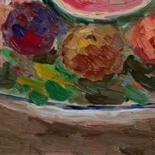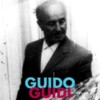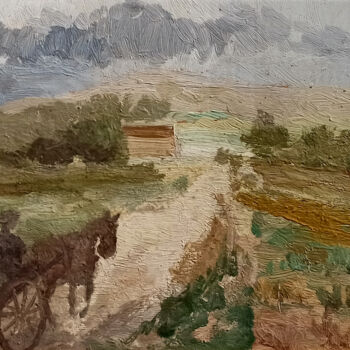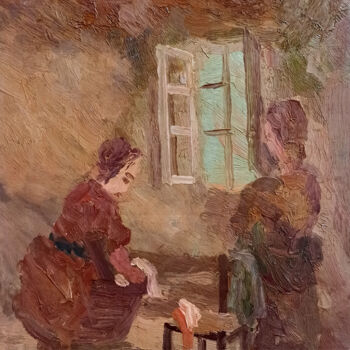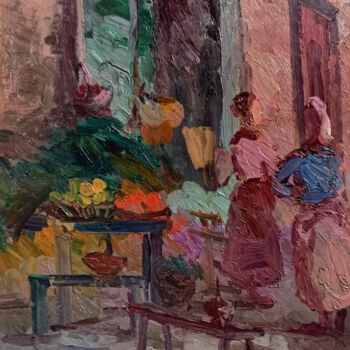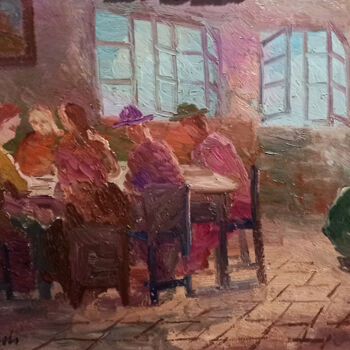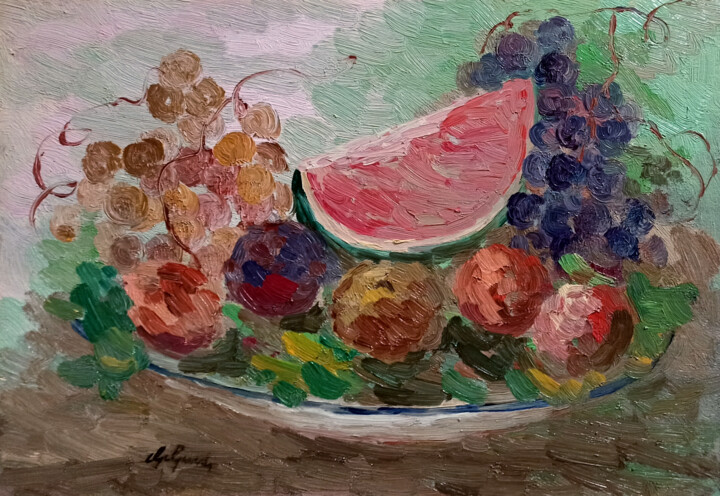
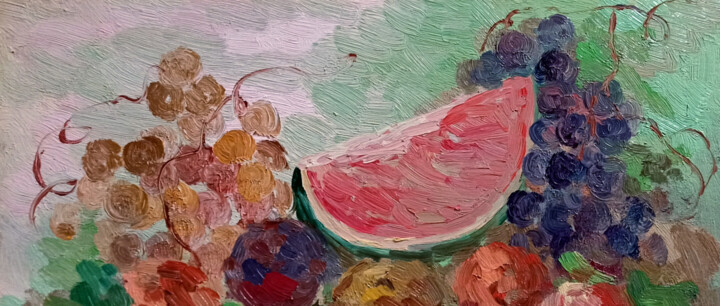

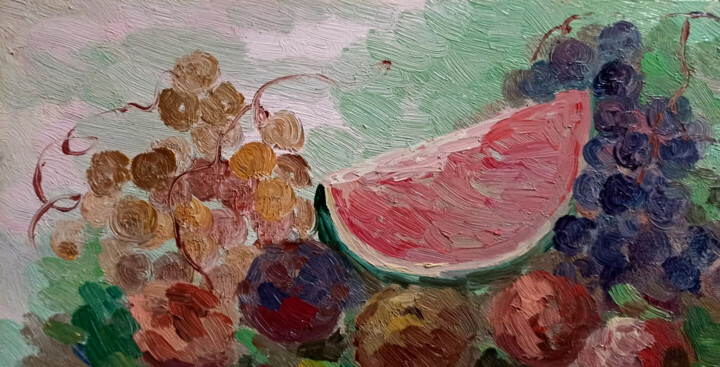
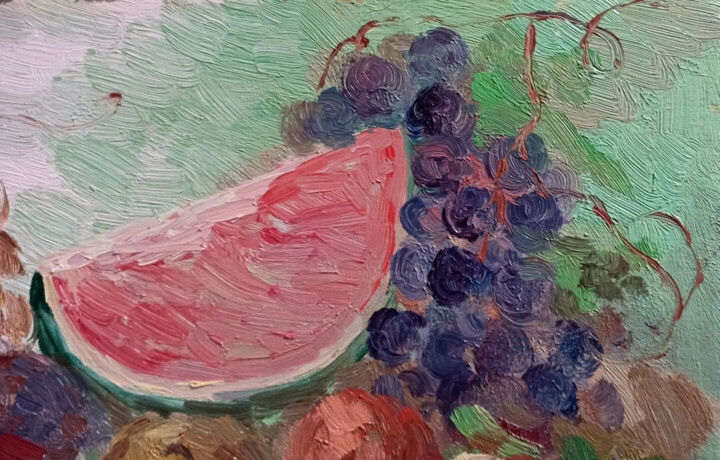
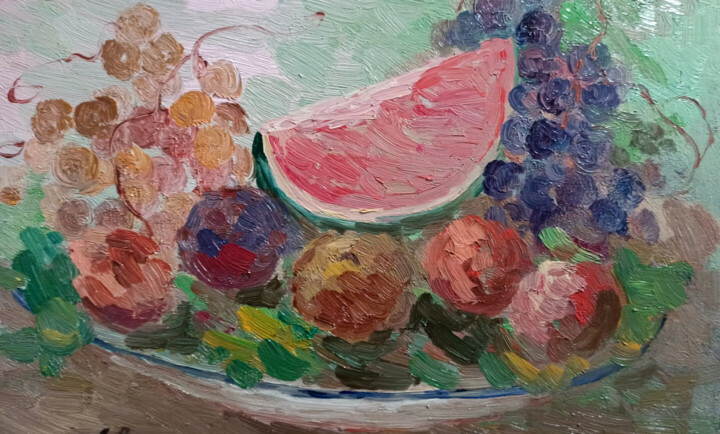
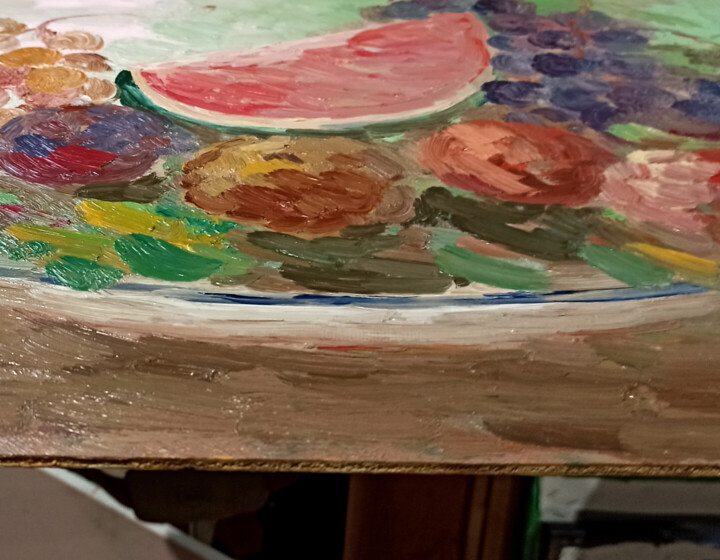
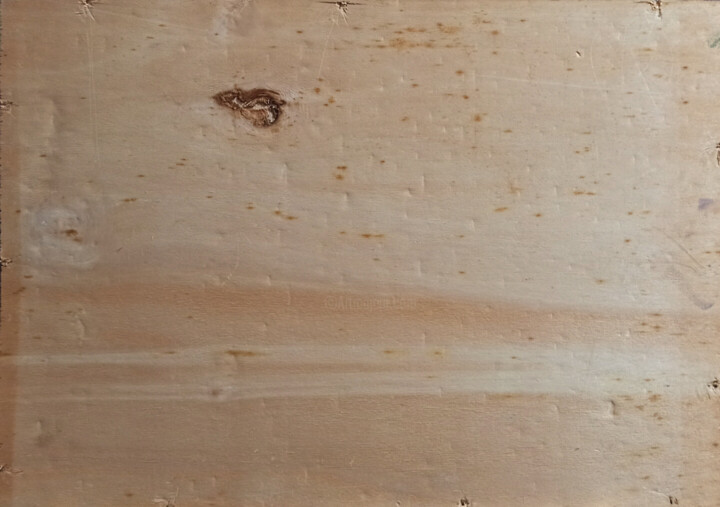
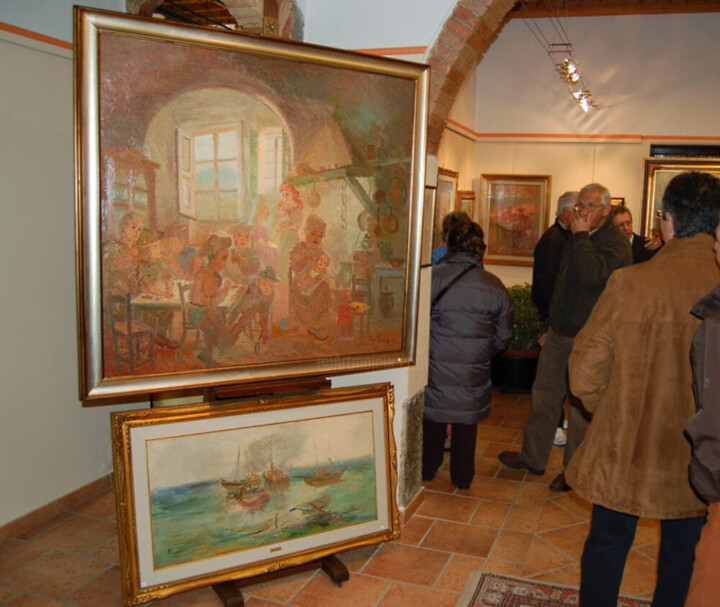
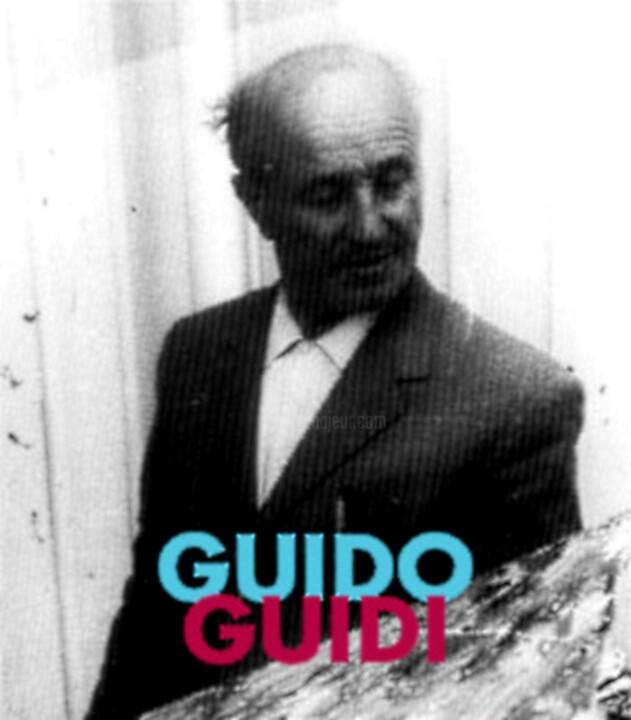


Faites-nous savoir si vous souhaitez voir plus de photos de cette œuvre !
- Arrière de l'oeuvre / Côté de l'oeuvre
- Détails / Signature / Surface ou texture de l'œuvre
- Oeuvre en situation, Autre...
Plate with fresh fruits - Italian old painting (1970) Peinture par Guido Guidi
Plus d'info
- Emballage (Boîte ou emballage en carton) Toutes les œuvres sont expédiées soigneusement protégées et assurées, avec un transporteur premium.
- Suivi Suivi de commande jusqu'à la livraison à l'acheteur. Un numéro de suivi vous sera fourni afin que vous puissiez suivre le colis en temps réel.
- Délais La plupart des colis sont livrés dans le monde entier sous 1 à 3 semaines (Estimation)
- Douanes non incluses Le prix ne comprend pas les frais de douane. La plupart des pays n'ont pas de taxe à l'importation pour les œuvres d'art originales, mais vous devrez peut-être payer la TVA réduite. Les frais de douane (le cas échéant) sont à calculer à l'arrivée par le bureau de douane et seront facturés séparément par le transporteur.
Plus d'info
- Certificat d'authenticité en ligne traçable Les certificats d'authenticité peuvent être vérifiés en ligne à tout moment en scannant le code de l'oeuvre.
- Certification de la cote artiste Les experts étudient l'œuvre et la carrière d'un artiste puis établissent une cotation moyenne indépendante et fiable. La cotation moyenne permet de situer l'artiste sur une gamme de prix pour une période donnée. Les experts peuvent également être sollicités pour établir une estimation plus précise pour une œuvre en particulier.
Plus d'info
Paiement 100% sécurisé avec un certificat SSL + 3D Secure.
Plus d'info
-
Œuvre d'art originale (One Of A Kind)
Peinture,
Huile
sur Bois
- Dimensions Hauteur 13,8in, Largeur 19,7in
- État de l'œuvre L'oeuvre est en très bon état
- Encadrement Cette oeuvre n'est pas encadrée
- Catégories Peintures à moins de 500 $US Surréalisme Nature
Original impressionist old painting of Italian painter Gino Guidi ( Livorno 1914 - 2000 ) - PostMacchiaioli surrealism School
Guidi's paintings must have an authentication, we will send our certificate in accordance with the law, stamped and signed
Medium : oil on wooden hardboard - 70s in good condition no restoration necessary
Title or subject : " Plate with fresh fruits - still life "
Measures painting : 35 x 50 cm - 13.7 x 19.6 inches - frame not included
The painting will be polished with "DAMAR" transparent varnish for protection and brilliance of the colours
Shipping by Fedex or DHL express from Italy
For any information we are at your disposition
GUIDO GUIDI
Guido Guidi (1901-1998) was born in Livorno, generally indicated as a link between the great Macchiaioli and subsequent generations. From an early age he demonstrated a certain predisposition for drawing, through which he established his own observations regarding shapes and colors, also showing a certain manual skill.
After completing his studies at primary school, in 1912 he enrolled at the Institute of Arts and Crafts, which he attended only for a short time, as he was soon called back to work as a cobbler by the family's serious economic conditions. Following this experience he decided to open his own shop in 1916, in the midst of the First World War, and in fact, he was called up to arms with the III Cavalry Regiment in Ferrara already in 1919. Despite the work to improve his own economic conditions and family members, he continued to exercise his passion for drawing through life studies. Even the war events did not stop his desire to experiment and from these years some scenes of military life remained, which later also returned in his painting, to testify how the artist lived this period intensely and how certain events remained imprinted in his memory.
In 1924 he exhibited his paintings in public for the first time in a collective exhibition called Cenacolo degli Illustri near Florence while, in 1927, the year of his marriage, he exhibited at Bottega d'Arte in Livorno with his first personal exhibition and linked his art for some time to his brother-in-law Galliano Masini, already an established tenor, who as an enlightened patron purchased his entire production, thus also alleviating the artist's psychological suffering.
Unfortunately, despite some exhibition successes and recognitions, such as the purchase of one of his paintings by the Royal House in 1936, the artist was never abandoned by a certain mental illness, also due to the end of his association with Masini, which forced him to frequent hospitalizations in Volterra and Pisa. This condition of economic and above all internal instability led to a move away from painting, coinciding precisely with the Second World War.
He enthusiastically resumed his activity at the end of the 1940s and 1955 marked his great return through an exhibition for the Rassegna di Arte Popolare in Rome, followed by another exhibition at the Bottega d'Arte in Livorno, in 1956, which was repeated in 1959. In 1961 he was also present in Florence at the Galleria Cancelli, as a member of the Labronico Group.
After several years spent practically in isolation, in close contact only with his own palette, the artist quickly found himself in contention among the most important Italian gallery owners and collectors who, struck by his very personal way of painting, invaded his studio. .
Thus began a period of intense exhibition activity for Guidi, which led him to visit all the most important Italian cities, through the largest artistic events of the Italian post-war period.
A recurring stop was for the artist in Livorno, where, in 1966, he held an anthological exhibition organized by the Municipality at the Casa della Cultura, which consecrated him among the greatest Labronian painters of the twentieth century, giving definitive recognition to his art.
In the Seventies his participations continued, both in large international events, such as the Biennial of European Contemporary Art, held in Athens in 1972, and in the most important Italian galleries.
In 1984, as further confirmation of the popularity and success achieved, a monograph was published by Matteoni Editori of Lucca, edited by Piero Caprile, Elio Mercuri and Adolfo Tucci. The last exhibitions were held at the Athena Gallery in Livorno, in 1996, and at the Giardino dell'Arte of Montenero, in 1997.
Guidi passed away in 1998 and his memory was immediately celebrated through a series of retrospectives dedicated to the person and the artist.
Guidi's art is born from his own, spontaneous need, which starts from his interiority. He is part of the group of artists who grew up developing their self-taught skills, living a little on the margins, but this must not be seen as something reductive for the artist, on the contrary, if he had not lived an experience of this type his art would certainly have had different developments and perhaps it would not have been free from external conditioning as it was. He was able to give free rein to his own interiority, to his own feelings, without using languages already used by others. Guidi constructs the shapes and figures through rapid, almost summary brushstrokes, blurring the contours of the subjects represented. The colour, always bright and lively, dominates, but never goes so far as to cancel out the figures portrayed. His painting is spontaneous, free, it does not follow a predetermined evolutionary path, it draws inspiration from everyday life, the forms and situations are recognizable by everyone. Through his canvases he is able to lower the observer into a space that seems to take him into an almost dreamlike dimension, perhaps precisely the result of his brushstrokes, his colours, the diffused brightness, which also remains linked to contexts and spaces which are those typical of the reality known and recognizable by all, which however appears here in an unexpected dimension.
Thèmes connexes
Guido GuidiNatura MortaItalian PaintingOld PaintingAntique Painting
Guido Guidi (1901-1998) est né à Livourne et est largement considéré comme la figure de pont entre les peintres Macchioli et la génération suivante. Dès son plus jeune âge, Guidi montre un penchant naturel pour l’art et, en 1912, il s’inscrit dans une école d’art. Cependant, en raison de difficultés financières, il a été contraint de partir après seulement quelques mois pour subvenir aux besoins de sa famille.
Malgré les défis, Guidi a persisté à poursuivre sa passion pour l’art tout en travaillant pour subvenir aux besoins de sa famille. Même en temps de guerre, il continue d’expérimenter son expression artistique, capturant des scènes militaires qui influenceront plus tard ses peintures.
La première exposition publique de Guidi a eu lieu en 1924 au "Cenacolo degli illustri" à Florence. En 1927, il réalise une exposition personnelle à la Bottega d'arte de Livourne, avec le soutien de son beau-frère, Giuliano Masini, qui achète plusieurs de ses œuvres. Cependant, la vie de Guidi a été marquée par des luttes psychologiques exacerbées par la fin de sa camaraderie avec Masini, qui a conduit à des périodes de traitement à Volterra et à Pise.
Malgré des revers, Guidi connaît un renouveau à la fin des années 1940. Son retour se consolide avec des expositions à Rome, Livourne et Florence tout au long des années 1950 et au début des années 1960. Malgré des années d'isolement, le style unique de Guidi a attiré l'attention d'éminents marchands d'art et collectionneurs de toute l'Italie.
Livourne est restée importante pour Guidi, culminant avec une exposition rétrospective organisée par la municipalité en 1966 à la Maison de la Culture, offrant une dernière reconnaissance de son héritage artistique.
La vie et l'œuvre de Guido Guidi illustrent la résilience et la détermination, surmontant l'adversité pour laisser une marque indélébile sur la scène artistique italienne.
-
Nationalité:
ITALIE

- Date de naissance : 1901
- Domaines artistiques: Représenté par une galerie,
- Groupes: Artistes Contemporains Italiens Artistes présentés par une galerie



